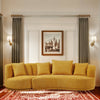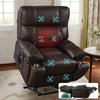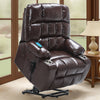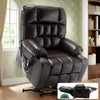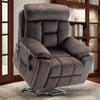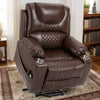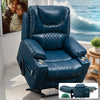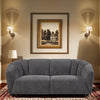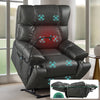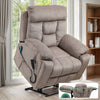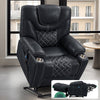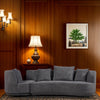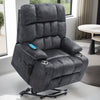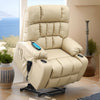The History and Rise of Recliner Chairs in American Homes
The Early Days of Recliner Chairs
Recliner chairs have a rich history in American homes. They first appeared in the late 19th century. Early models were simple and functional. They had a basic tilting mechanism. The chairs were made of wood and leather.

Comfort was the main focus of these early designs. They were popular among the elderly and those with health issues. The ability to adjust the chair's position was a big selling point. It offered relief from back pain and improved circulation.
As time went on, recliners became more advanced. Springs and padding were added for extra comfort. The designs became more stylish to fit in with home decor. By the early 20th century, recliners were gaining popularity in middle-class homes.
The Growth of Recliner Popularity in the 20th Century
The mid-20th century saw a boom in recliner popularity. After World War II, there was a surge in suburban living. New homes needed furniture, and recliners fit the bill. They were comfortable and practical for relaxing after a long day at work.
TV became a central part of American life in the 1950s and 60s. Recliners were the perfect seat for watching shows. Many were designed with built-in cup holders and snack trays. This made them ideal for long viewing sessions.
Mass production techniques made recliners more affordable. More families could buy them. Brands like La-Z-Boy became household names. They offered a wide range of styles and features. Recliners became a symbol of comfort and leisure in American culture.
Factors Contributing to the Popularity of Recliners
Several factors led to the widespread adoption of recliners:
- Comfort: Recliners offered unmatched comfort for relaxation.
- Versatility: They could be used for various activities, from reading to watching TV.
- Health benefits: Many found relief from back pain and improved circulation.
- Affordability: Mass production made recliners accessible to more people.
- Marketing: Clever ads positioned recliners as must-have items for modern homes.
- Design variety: A wide range of styles suited different tastes and decor.
- Technological advances: Features like heating and massage were added over time.
The rise of lay flat recliner chairs was particularly notable. These allowed users to recline fully, almost like a bed. This feature was popular for napping or overnight guests. It added another layer of versatility to the recliner's appeal.
The Shift from Recliners to Modular Sofas
The Evolving Aesthetic of Living Room Furniture
As home design trends changed, so did furniture preferences. The bulky look of traditional recliners started to feel outdated. People began to favor sleeker, more modern designs. This shift opened the door for modular sofas.

Modular sofas offered a fresh, contemporary look. They could be arranged in various ways to fit different spaces. This flexibility appealed to homeowners who wanted versatile furniture. The clean lines and minimalist design of modular sofas matched modern interiors.
Color choices also evolved. While recliners often came in dark leather, modular sofas offered more options. Bright colors and patterns became popular. This allowed for more personalization in living room decor.
Advantages of Modular Sofas Over Traditional Recliners
Modular sofas brought several benefits that recliners couldn't match:
- Flexibility: Pieces could be rearranged to suit different needs or room layouts.
- Space efficiency: Modular designs made better use of available space.
- Seating capacity: They could accommodate more people than individual recliners.
- Style variety: A wide range of designs fit various aesthetic preferences.
- Customization: Buyers could choose the number and type of modules they wanted.
- Ease of moving: Separate pieces were easier to transport than bulky recliners.
- Adaptability: Modules could be added or removed as needs changed over time.
While recliners focused on individual comfort, modular sofas promoted social interaction. They created spaces where families and friends could gather comfortably. This shift reflected changing priorities in home life and entertainment.
Impact of Lifestyle Changes on Furniture Preferences
Modern lifestyles have greatly influenced furniture choices. Open-plan living has become more common. This calls for furniture that can define spaces without walls. Modular sofas excel at this, creating distinct areas within larger rooms.
Work-from-home trends have also played a role. People need furniture that can serve multiple purposes. A modular sofa can be a workspace by day and a relaxation spot by night. This versatility is highly valued in smaller homes or apartments.
Environmental concerns have affected choices too. Many modular sofas are made with sustainable materials. They can be easily repaired or have parts replaced. This appeals to eco-conscious consumers who want long-lasting furniture.
Future Trends in Living Room Furniture Design
Innovations in Recliner Technology and Design
Despite the rise of modular sofas, recliners are not disappearing. They are evolving to meet modern needs. New technologies are being incorporated into recliner design. This is breathing new life into this classic piece of furniture.

Smart recliners are gaining popularity. These chairs can be controlled by smartphones or voice commands. They offer features like:
- Adjustable lumbar support
- Memory settings for preferred positions
- Built-in charging ports for devices
- Heating and massage functions
- Health monitoring capabilities
Designers are also working to make recliners more stylish. Sleeker profiles and modern materials are being used. This helps recliners fit better with contemporary decor. Some even combine recliner functionality with the look of a regular armchair.
The Role of Modular Furniture in Future Living Spaces
Modular furniture is likely to play a big role in future homes. As living spaces become more compact, especially in urban areas, flexibility will be key. Modular designs allow for easy adaptation to changing needs.
We may see more integration of technology in modular sofas. Built-in speakers, charging stations, and even holographic displays could become common. This would turn the sofa into a central hub for home entertainment and connectivity.
Sustainability will continue to be important. Future modular sofas might be made from recycled materials. They could be designed for easy disassembly and recycling at the end of their life. This aligns with growing environmental awareness among consumers.
Predicting Consumer Demand for Furniture in the United States
Looking ahead, several trends are likely to shape furniture demand in the US:
- Multi-functional pieces will be popular as living spaces get smaller.
- Customization options will increase to meet individual preferences.
- Smart furniture with integrated technology will become more common.
- Eco-friendly and sustainable designs will be in high demand.
- Comfort will remain a priority, but not at the expense of style.
- Modular designs will continue to grow in popularity for their flexibility.
- Health-focused features, like ergonomic support, will be important.
The future of living room furniture will likely blend the best aspects of recliners and modular sofas. Comfort, flexibility, and style will all be key factors. As homes and lifestyles continue to evolve, so too will the furniture that fills our living spaces.







